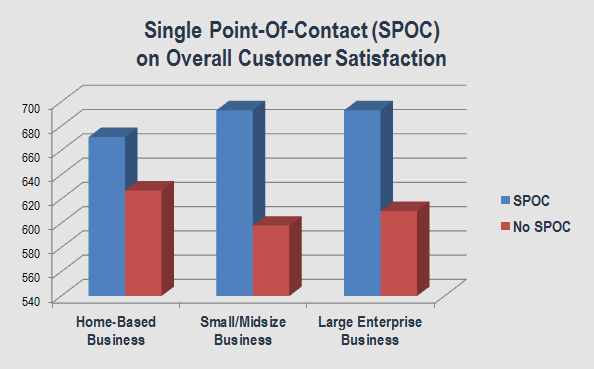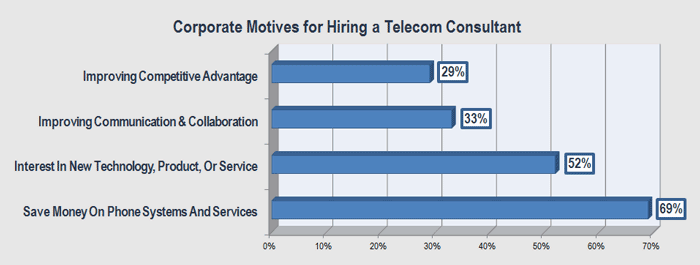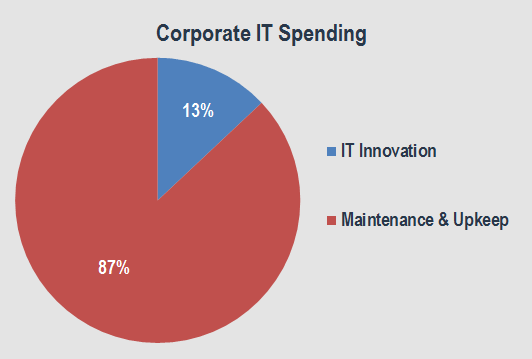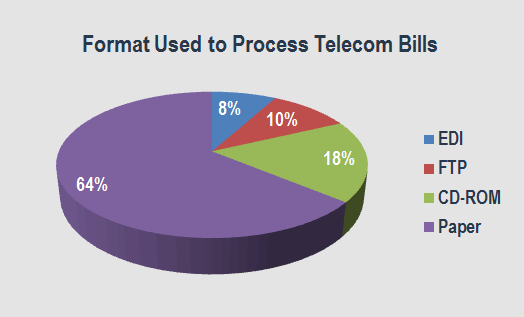Effect of Single Point-of-Contact (SPOC) on Customer Satisfaction
This study by J.D. Power1 finds that business customers with a single point-of-contact have higher rates of problem resolution than customers who are not provided with a dedicated contact. In all three segments, problem resolution rates average approximately 90 percent among customers with a single point of contact. For customers without a dedicated contact, problem resolution rates average between 74 percent and 83 percent. In addition, assigning a dedicated contact to a business account may also reduce the likelihood of customers to switch providers.

Source: J.D. Power & Associates1
Corporate Motives for Hiring a Telecom Consultant
A survey of telecom consultants not affiliated with vendors2 found that Small to Medium Businesses (between 6 and 999 employees) represent the largest growth sector of clientele. The increasingly complex nature of telecom services is the main motivating factor for this segment to seek out a telecom consultant. Other factors include an interest in new technology and the expertise of consultants to recommend the appropriate services that can ultimately increase “collaboration and communication”.

Source: Brookside Group2
Billing Complexity
According to a report by the Aberdeen Group3, each month mid-market U.S. companies receive more than 300 telecom-related bills each month. Separate bills are sent to different office locations with more than 100 pages of complex line items. Adding to an already complex scenario is the fact that the majority of companies receive their telecom bill in paper format which can lead to inefficient manual processing resulting in “lost bills, uncontrolled service disconnects, and late payment penalties”3.
The report also shows that “complex carrier services, contracts, and legacy billing systems produce invoices with historical error rates of 7% to 12% for telecom services”3.
Decline in IT-related Productivity
A report by Pricewaterhouse Coopers4 finds that companies are spending more on IT; however, despite rising IT budgets there is a decline in IT-related productivity. Rapid changes in and an increasing complexity of IT is eating up corporate IT budgets. According to Gartner5 More money is being allocated to the maintenance and upkeep of “disparate software and hardware systems and tools” rather than focusing on innovation to extract efficiency from IT services and processes.

Source: Gartner IT Key Metrics Data 20085
References
1J.D. Power & Associates Report. (2010). Having a Single Point of Contact Has a Notable Positive Effect on Satisfaction with Telecommunications Voice Services Providers.
22008 State of the Market Study. Summary. (2008). The Brookside Group.
3 The Challenge in Total Telecom Cost Management. (2006). The Aberdeen Group.
4 Why isn’t IT spending creating more value? (2008). Pricewaterhouse Coopers.
5Gartner IT Key Metrics Data. (2008). Gartner, Inc.
6Newton, Harry. (2013). Newton’s Telecom Dictionary. 27th Expanded and Update Edition. Flatiron Publishing, New York: New York.
7Lytle, J. (2010). Make the call: Telecom negotiations require steady nerves and a willingness to change. Compass Publishing.














































